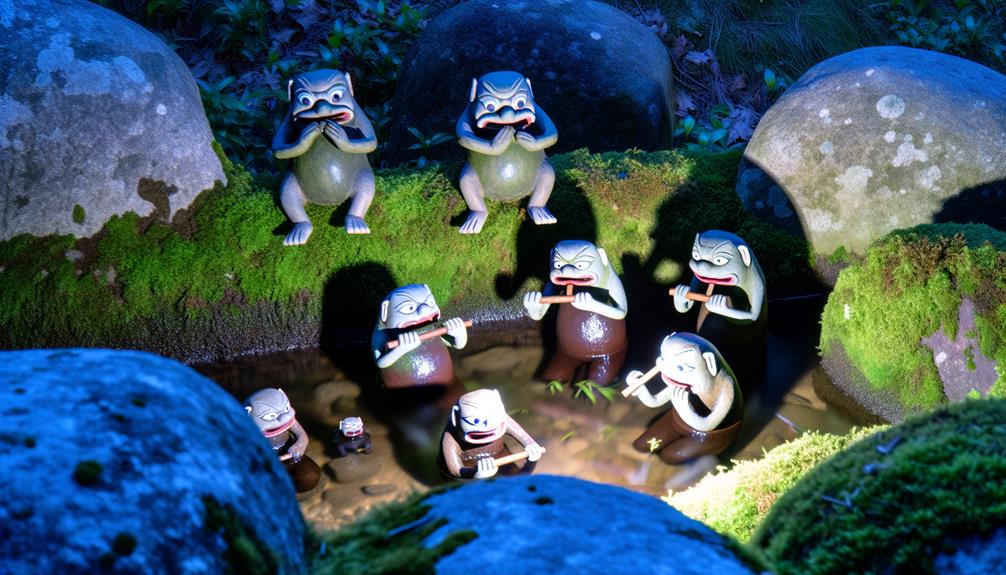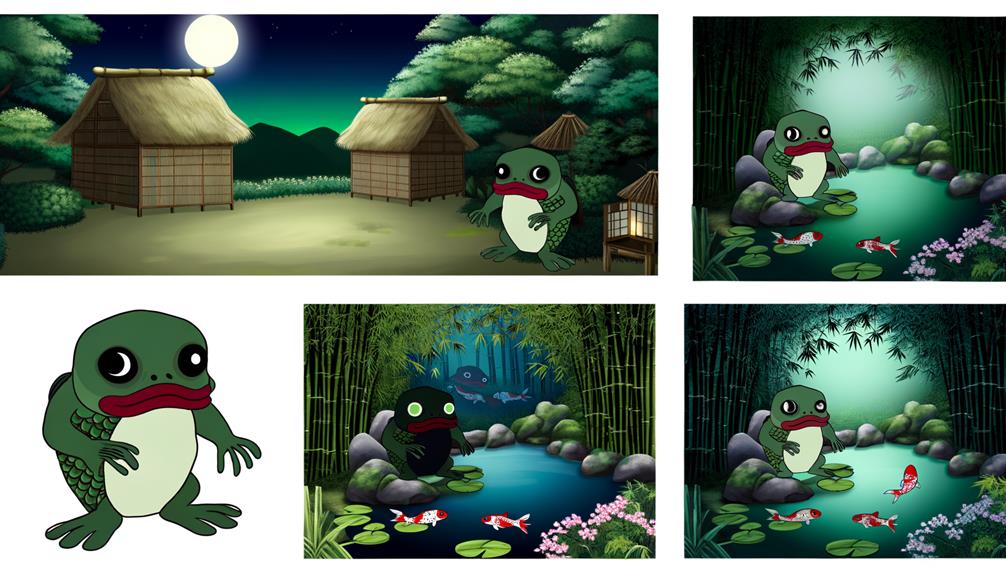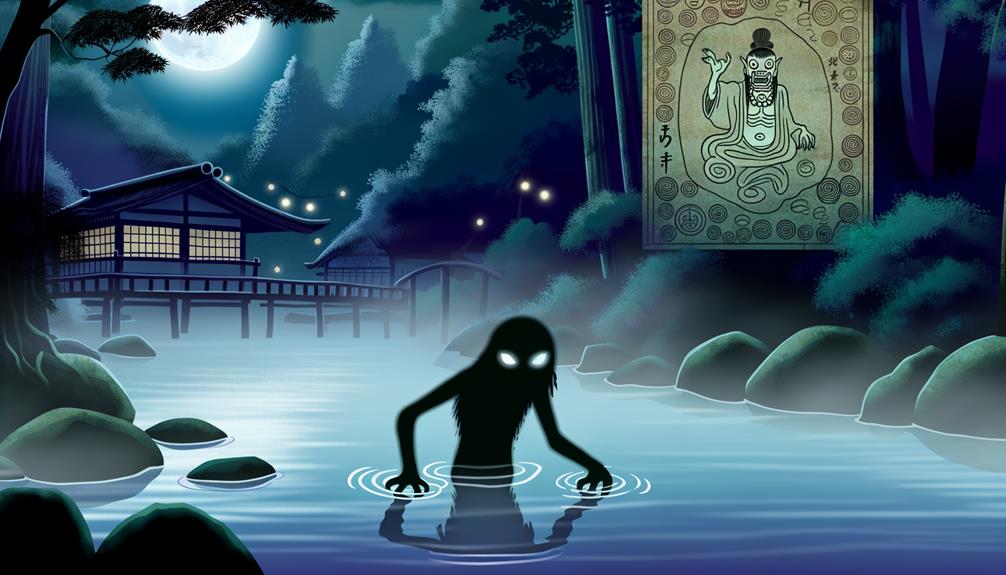Have you ever heard about the Kappa? This is a creature from Japanese folklore that lives in the quiet, picturesque rivers and lakes of Japan. Known for their smarts but also their mischievous behavior, these mythical beings have been part of many tall tales for hundreds of years. As someone who studies these kinds of stories, I've always been drawn to tales about the Kappa. They're not just entertaining, but they also give us a unique glimpse into Japanese culture. The stories are filled with wit, danger, and show us a lot about the hopes, fears, and sense of humor of the Japanese people. Isn't it interesting that the Kappa is portrayed as both a prankster and a skilled healer? And why on earth would it like cucumbers of all things? To get to the bottom of these quirky details, we'll need to dive deeper into the mysterious world of Kappa folklore.
Unveiling the Kappa's Appearance

Did you know there's a mythical creature from Japan that's often mistaken for a kid? Meet the Kappa, a water sprite with a unique look. It has a greenish or yellow-blue skin tone, scaly or slimy skin, webbed hands and feet, and a shell-like covering on its back, much like a turtle. This unusual blend of human-like and animal features makes it an intriguing figure in the world of folklore.
But there's more to this creature than just its looks. Despite their small size, Kappas are surprisingly strong, even more so than a full-grown man. And you'll find one feature that sets them apart – a tiny pool of water atop their head. Legend has it, this pool is the Kappa's power source; if the water dries up or spills, the Kappa loses its strength.
When you take a closer look at the Kappa, you'll notice a total of 29 unique characteristics, including their webbed appendages and unexpected physical strength. These features paint a vivid picture of the rich, varied world of Japanese mythology. They also highlight the need to understand these mythical figures within the context of their own culture. It's a fascinating journey into a realm of fantasy that offers a glimpse into cultural beliefs and traditions.
The Mysterious Kappa Behavior

Kappas, these mystical beings, are quite an interesting species to study, not just for their unique physical features but also for their odd behaviors. Found in rivers and lakes all across Japan, every region has its own tales about these river-dwelling creatures, giving us a glimpse into the enigmatic world of the Kappas.
Their behaviors swing wildly between friendly and downright dangerous. Kappas are known to engage in petty misbehavior, and at times, they can get pretty scary, kidnapping children or drowning people and animals. However, they have a strange love for cucumbers – a fact often used to placate them during celebrations.
Now, when it comes to humans, Kappas can be surprisingly helpful. For example, a Kappa that has been befriended might lend a hand to farmers with their irrigation needs or bring fresh fish, which is seen as a sign of good luck. But, they're not fans of iron, sesame, or ginger and can be scared away with these items. Also, if you manage to remove a Kappa's arm or bow to it deeply, it might just return the favor or share some wisdom.
Strategies to Defeat Kappa
Dealing effectively with Kappas, notorious supernatural beings from Japanese folklore, is quite the challenge. These water deities, whose origins trace back to the Edo era, are known for causing quite a ruckus. Let's dive into some tried-and-true tactics for handling Kappas, gleaned from centuries of cultural know-how.
First off, Cucumber Gifts: Turns out these aquatic troublemakers have a soft spot for cucumbers. A cucumber could potentially pacify or distract them.
Secondly, Respectful Gestures: Kappas are sticklers for etiquette. A deep bow could put them in a never-ending cycle of reciprocating the gesture.
Next, Arm Bargaining: This may seem a bit harsh, but if you manage to detach a Kappa's arm, they might offer valuable information or favors in hopes of getting it reattached.
Lastly, Skill Challenges: Pit yourself against a Kappa in a round of shogi or a sumo wrestling match. If they lose, they might just decide to leave.
Regional Variations of Kappa Tales

When you start to delve into the topic of regional variations, it quickly becomes clear that Kappa stories and folklore have a tendency to change and evolve, assuming unique characteristics like different names – 'kawako' in Izumo and 'gatarō' in Hyōgo Prefecture, for example. These differences reflect the specific cultural quirks of each region. Kappa, one of the most renowned figures in Japanese mythology, is an incredibly interesting topic to investigate. You'll find that tales of kappa creatures in rivers show a remarkable range of variation from one part of the country to another.
The ways that people try to keep the kappa happy, such as the custom of feeding them cucumbers, can also differ from one region to another. This highlights the depth and richness of the variations in Kappa stories across different regions. The methods people use to scare away or defeat kappa, which often involve local traditions or items, also vary. For instance, the mythical ball – an integral part of many stories – is employed in a variety of ways in different regions.
The cultural importance of kappa isn't the same everywhere, and this results in unique interpretations and practices. You can see this in the kappa-specific shrines and festivals, which have different customs and practices and are usually located near water. These differences highlight the flexibility of kappa in folklore and show how they reflect the diverse cultures found in different regions of Japan.
Kappa Legends in Modern Culture

No doubt, regional stories about kappa have a particular allure. But it's captivating to observe how these fables have seeped into current culture, influencing literature, art, and mainstream media. These accounts of the kappa, a river-dwelling creature, have been reimagined and adapted to suit present-day tales, preserving their classic features like child-like size and webbed feet.
To give you a clear picture, let's talk about four instances where kappa have made their mark in modern culture:
- Literature: Today's Japanese novels and comic books often portray kappa, preserving their playful yet sometimes menacing nature.
- Art: The distinct look of kappa, complete with webbed feet and a plate on their heads, continues to spark the creativity of artists, both in traditional mediums and digital platforms.
- Media: In movies and TV shows, kappa are represented as both villains and heroes, their narratives often linked to the rivers they supposedly reside in.
- Video Games: Kappa have carved a niche in the lore of video games, typically as characters that players can engage with or challenges to defeat.
These instances show how kappa have journeyed from their river homes onto terra firma and into the minds of the general public. Their legends have progressed, but their core characteristics remain unchanged.
Frequently Asked Questions
What Is the Mythical Creature Kappa?
Well, today's talk isn't about any water-based monsters. Instead, it's about the Kappa, a creature soaked in Japanese mythology. Picture it as a humanoid, but with a turtle's shell, webbed hands and feet, and a mouth that resembles a beak. It's known for its mischievous nature and has a strange fixation with cucumbers.
What Is the Meaning of the Animal Kappa?
Have you heard about the Kappa from Japanese folklore? It's not an animal, it's a mythical being instead. The Kappa has a strong link to water and is seen in a dual light – sometimes it's considered malicious, other times it's seen as a helper. An interesting aspect of the Kappa? It's got a serious thing for cucumbers and it's known for its ability to change – pretty cool, right?
What Is the Real Story of Kappa?
So, you want to know the real deal about Kappa? Well, sit tight because it's quite a tale! Kappa are legendary creatures from Japan, known for their double-edged nature. They're infamous for pulling people into water, but they can also lend a hand when you need it. It's interesting how their portrayal has shifted over the years, from downright scary to sort of goofy.
Is Kappa a Good YōKai?
Absolutely, a kappa can definitely be a good yōkai! It's true that their reputation isn't always the best because they're notorious for their naughty and sometimes harmful pranks. But did you know they also help out humans and bring them fresh fish? As you can see, they're not all bad. In fact, over the years, people's perception of them has gradually shifted. These days, in a more contemporary context, they're often seen in a much more positive light.

